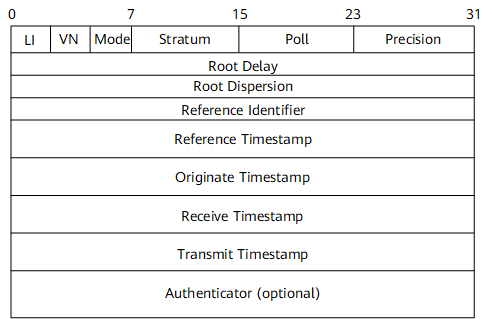Format of NTP Messages
Figure 1 shows the format of NTP messages.
Field |
Length |
Description |
|---|---|---|
Leap Indicator |
2 bits |
A code warning of an impending leap second to be inserted or deleted in the last minute of the current day. The 2 bits, bit 0 and bit 1, are coded as follows: 00: no warning. 01: last minute has 61 seconds. 10: last minute has 59 seconds. 11: alarm condition (clock not synchronized). |
VN (Version Number) |
3 bits |
NTP version number. The current version is 3. |
Mode |
3 bits |
NTP mode: 0: reserved 1: symmetric active 2: symmetric passive 3: client 4: server 5: broadcast 6: reserved for NTP control messages 7: reserved for private use |
Stratum |
8 bits |
Stratum of the local clock. It defines the precision of a clock. The value that can be displayed in this field ranges from 1 to 15. The clocks at Stratum 1 are the most precise. |
Poll |
8 bits |
Minimum interval between successive messages. |
Precision |
8 bits |
Precision of the local clock. |
Root Delay |
32 bits |
Roundtrip delay (in ms) between the client and the primary reference source. |
Root Dispersion |
32 bits |
Estimated dispersion to the primary reference source. |
Reference Identifier |
32 bits |
ID of a reference clock. |
Reference Timestamp |
64 bits |
Local time at which the local clock was last set or corrected. Value 0 indicates that the local clock is never synchronized. |
Originate Timestamp |
64 bits |
Local time at which the NTP request is sent by the client. |
Receive Timestamp |
64 bits |
Local time at which the request arrives at the time server |
Transmit Timestamp |
64 bits |
Local time at which the response message is sent by the time server to the client. |
Authenticator |
96 bits |
Authenticator information. This field is optional. |
